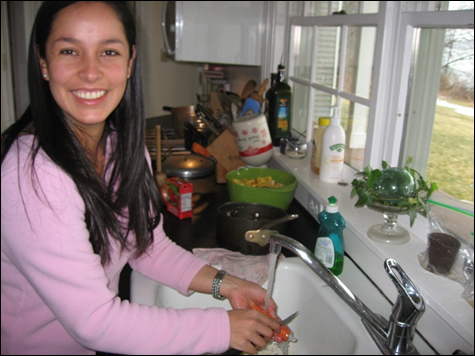
JUST LIKE MOM'S: Colombian home-cooking. |
Beans of Sogamoso, Colombia
(Serves 4-6; serve with rice, and meat if you like)
1.5 cups dry red beans
half a carrot, peeled
1 clove garlic, crushed
1 teaspoon salt, plus more to taste
quarter-cup minced yellow onion
1 cups crushed tomato
Olive oil
Soak the dry beans in water in a large bowl overnight. The next day, at least two hours before you want to eat, pour the beans, with the soaking water, into a medium pot. Add the carrot, garlic, salt, and enough water so the beans are covered by two inches. Cook the beans covered on medium heat, adding water if necessary to keep beans from drying out. Next, cover the bottom of small sauté pan generously with oil. Add onion and crushed tomato and cook, stirring occasionally, for about 15 minutes until the red color turns ever so slightly orange. Remove from heat. When the beans are almost completely soft, add the tomato-onion mixture, called guiso, to the beans and season with salt. Finish cooking until the beans are really soft, hearty, and rich.
_LS |
My bad. I had assumed the choice of beans — black, pinto, or refried — was a Latin American thing. Karen Ballesteros, a Colombian 23-year-old working as a nanny here, pleasantly set me straight. “When I came to the US, I saw black beans for the first time.” It got me thinking, scrambling for a map, and counting. There are arguably 24 Latin American countries in the world, from Mexico to Chile. Sure, all these countries have something in common, a popular language derived from Spanish (if we skip Brazil, which is more Portuguese-influenced), but why, with unimaginably various topographies, histories, habitats, and traditions, should I assume all their beans are the same?Karen pronounces her name Kah-ren, with that Spanish speaker’s r, more of a staccato flutter of the tip of the tongue against roof of the mouth than the guttural sound made with a squat tongue in retreat. Kah-ren (got it?) was teaching me how to make beans and rice the way she learned how to make them when she was growing up in Sogamoso, Colombia. Was this the way beans were made all over Colombia? She couldn’t know. Colombia itself, she told me, is made up of so many different places: cities high up in the mountains where apples, potatoes, and tomatoes grow in 60-degree temperatures year-round, and cities low in elevation where in the heat of the afternoon people pick guavas, mangos, and pineapples from their backyards and blend them with sugar for afternoon spritzers. The dried beans in Sogamoso are dark red, and stay that way through cooking. She didn’t even know in Spanish what they were called. “Rojo,” her face squinched as her hands made the gesture for "little."
The beans she used during our cooking session she found in her employer’s pantry. They were off-white, with little speckles of rouge, but as they cooked, they turned dark red, the color of her beans back home.
Lindsay Sterling can be reached at lindsay@lindsaysterling.com.
 Related
Related:
Coda, Open-air entrepreneurs, Petit Robert Bistro, More 
- Coda
I will be in one of those ice-cream parlors where the special is rye-whiskey-macadamia-nut-blue-cheese sorbet, and I will hear myself ordering . . . vanilla.
- Open-air entrepreneurs
Where are all the street vendors?
- Petit Robert Bistro
This is Petit Robert Bistro #2, or II, or deux. Or, since this space, formerly Rouge, is smaller than the original Petit Robert, maybe it’s Plus Petit Robert.
- Party of six
The opportunity to gather six of the city’s most talented chefs together at one table and engage in a lively heart-to-heart about all things culinary is extremely rare.
- Zoe’s Gourmet Chinese Cuisine
The name is almost as big as the 10-table restaurant.
- Caffe Italia
There are actually two restaurants called Caffe Italia in East Boston: this one, behind the tunnel entrance, between Central and Maverick Squares; and Caffe Italia II, in Jeffries Point, on Bennington Street.
- Lineage
There are at least three kinds of lineage invoked here.
- Middle of Nowhere Diner
Lions, and tigers, and bears — oh no!
- Wetherlaine’s
It’s where Box Seats, the sports bar up in Woonsocket, used to be.
- Pho Republique
Retro done right sits well with me, and the refined fusion dishes here can be remarkable.
- Wisteria House
As one of Boston’s first Taiwan-style restaurants, Wisteria House had a 10-year run on Newbury Street. It has now moved its operations to Cambridge.
- Less

 Topics
Topics:
Food Features
, Culture and Lifestyle, Food and Cooking, Foods, More  , Culture and Lifestyle, Food and Cooking, Foods, Fruits and Vegetables, Recipes, Lindsay Sterling, BEANS, BEANS, Less
, Culture and Lifestyle, Food and Cooking, Foods, Fruits and Vegetables, Recipes, Lindsay Sterling, BEANS, BEANS, Less 